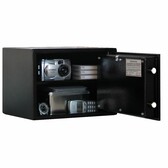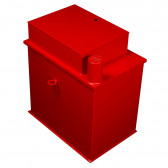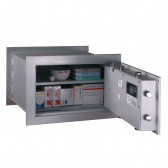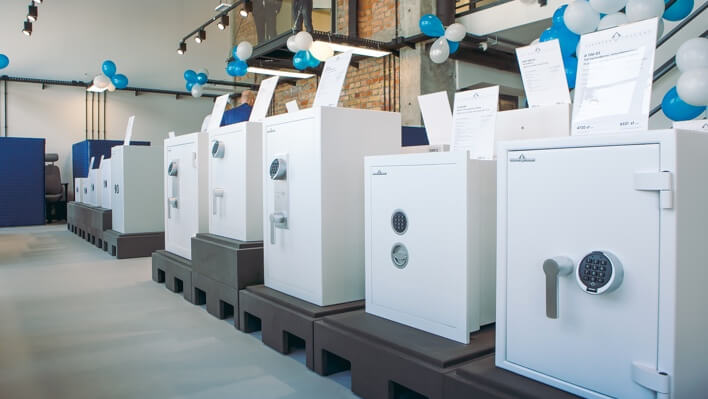The location of a safe is one of the most important aspects of having one in your house or flat. When choosing a strongbox, you will undoubtedly wonder where it will fit best in your space. Today, we'll try to approach this in a few ways and may be able to clear up your doubts.
Installation is important – protect your new home safe further from theft
The cruel truth about securing possessions is that any safe weighing less than 1,000 kg should be permanently mounted to the floor or wall. Otherwise, its security class will not be maintained despite being made to the correct norms and standards. Even a large safe that you set up, seemingly in a secured place, needs to be anchored.
The second reason for installing a safe is a purely practical argument. Free-standing safes with a high burglary and/or fire resistance rating will weigh their own weight but a determined and equipped thief will undoubtedly attempt to take the strongbox to a secure spot where he can break into it without pressure and it is only a matter of time. If the safe is not properly installed, there is always the possibility of theft or loss of your valuables stored therein.
The installation of the safe is therefore, along with its security grade and weight, the third most essential piece of the jigsaw to ensure the comprehensive protection and security of your precious things or money. Each step in the installation process is crucial for ensuring maximum protection against break-in and theft.
Before choosing and installing the strongbox, careful planning and research are essential to minimize risks and ensure the highest level of security.
Where to install a safe – or how to hide the safe at home effectively
The question "how to hide a safe?" comes up quite often. When choosing where to install it, you think about the fact that if you hide the strongbox, a thief will not find it. Contrary to what you may think, it is not easy to conceal a safe in places that are not so obvious that it is actually effective.
The places where to install safe in house or flat are actually several:
• in the bedroom,
• in the wardrobe,
• in the wardrobe in the hallway,
• in the study,
• in the storage space under the stairs,
• in the garage,
• in the basement,
• in the wall,
• in the floor.
All of these locations have their pros and cons; however, remember that wherever you decide to place the safe, the resistance grade, the weight and professional installation of the safe, rather than the location itself, will primarily determine your level of theft protection.
Security hygiene is also important. If you decide to install a safe in your home, keep this information for yourself and your household members. Outsiders should not even know that you want to put a strongbox in your house, and the information about what you will store in it and where the safe is installed should be a secret to outsiders in particular.
Where does a thief look most often?
Exactly there where you do. A thief looks in places where he would hide a safe himself, so placing a strongbox even in the most finely tuned location is not 100 per cent certain to put a safe away successfully.
You can therefore be sure that any places in your home where you could hide a safe will be carefully checked: bedroom wardrobes, dressing room, study, basement or garage. Hiding a safe "for good and all" is in obvious contradiction to the everyday use of a strongbox. A safe in a house is mainly used to store weapons, documents, valuables and money, i.e. items that you want to have easy access to.
Installing a safe in the wall
Wall safes are such a popular topic that it is worth devoting a separate paragraph to them.
A wall safe differs from free-standing models in that its interior is protected by a door with concealed hinges, allowing for a flat front. The downside is that the opening angle of a wall safe door is limited to 90 degrees. It is installed in a pre-prepared recess in a load-bearing wall, so when choosing a wall safe, you must have a wall of sufficient thickness.
As a rule, it is a small safe – although wall safes can be of any size – which is characterised by concealed hinges that allow the front panel of the door to be covered by panels or a picture. Such a safe can be installed at any height and flanked by a piece of furniture at home, such as a chest of drawers, or even placed inside a piece of furniture, in the lower parts of a wardrobe, etc.. Wall safes are therefore concealed and not visible at first glance.
Read more: The wall safe – everything you need to know about it
Floor safe
A certain variation on the theme of safes designed to be invisible are floor safes. These units are embedded in the floor and poured with concrete all around, and the door is covered with panels so you can literally walk around the safe. This makes them extremely difficult to remove or tamper with. It is a bit of a hassle to get inside it, but in this case concealment is the priority. The doors of floor-mounted safes open upwards thanks to pneumatic supports.
One of the main advantages of floor safes is their ability to protect valuables from both burglary and environmental factors such as moisture. Proper installation work is crucial to ensure the safe remains secure and functional over time. Knowing the correct placement and installation steps can significantly enhance the overall security of your possessions.
While accessing a floor safe might require a bit more effort due to its concealed nature and upward-opening door supported by pneumatic arms, this trade-off is worthwhile for the added protection it provides. These safes are ideal for storing important documents, heirlooms, weapons, data carriers, and other valuables that require a high level of security.
In order to maximize the effectiveness of your floor safe, it is recommended to choose a location with a flat, stable surface and to conduct thorough research before installation. This will help avoid potential issues related to moisture or structural weaknesses in the floor, which could compromise the safe's integrity.
Overall, floor safes offer a robust and discreet solution to protect your most valuable possession, combining concealment with high security standards to deter theft and damage.
What can be stored in a home safe?
A home safe is designed to serve you, so you can store anything that is valuable to you. This could be important documents, precious things, family heirlooms, weapons or data carriers. Protecting these items is of great value, as it ensures their safety and preserves their worth for years to come. Investing in a reliable strongbox brings additional value to your home security by combining quality, reliability and cost-effectiveness. Safes are designed to give you a sense of security when you are not at home. A safe at home, whether it contains documents or financially valuable items, is meant to give you comfort and help you in your everyday life.
Summary
Installing a safe in your home is not an easy task. You can install a strongbox in various, non-obvious places at home; however, remember that the safety of your valuables will primarily depend on: the security grade and quality of the strongbox, its weight, fire resistance and professional installation, and only then on the assembly location itself. A thief will search for safes until (s)he finds one, and (s)he is very likely to succeed. Our job is to make sure that what you keep in your safe does not fall into their hands. If you have any questions or concerns, we are here for you!





